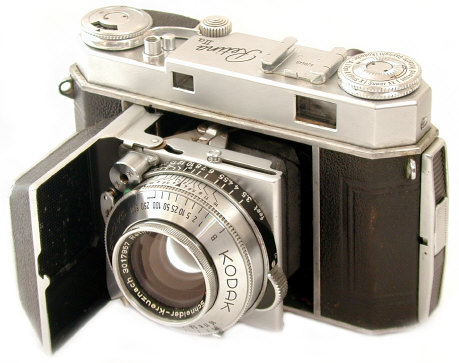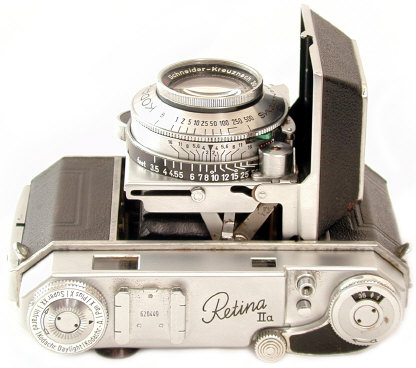

Home Camera Articles FOR SALE Orders I Buy / Wants Repairs Books Adapters


The Kodak Retina IIa is my favorite of the long lived Retina series, the epitome of a classic small fast lensed 35mm folder. What makes it so good? It's small size, superb 50/2 Xenon or Heligon lens, better than average finder, quiet leaf shutter, and the simple straightforward design which translates to pleasurable shooting. The IIa was produced only from 1951 to 1954, yet over 100,000 were produced. In a nutshell, many Retina fanatics feel the earlier Retinas had less of the desirable features, while the later Retinas sacrificed too much size and weight for additional features. The IIa is Type 016 in Retina nomenclature.

Fixed 6 element 50/2 Schneider Xenon or Rodenstock Heligon lens (lenses or lens elements will not interchange like the later Retinas), filter size 29.5 mm screw in or 32 mm push on
Close focus 2.5 feet
Shutter 1 to 1/500th, plus B
Electronic flash sync at all speeds
Flash connection on bottom of lens assembly, no hot shoe
Combined RF/VF, no bright line or parallax correction, relatively bright and big view for its time, better than a Leica IIIf finder
IMPORTANT: Make sure you advance the single stroke advance lever to its full limit
The manually reset film counter counts DOWN, showing how many unexposed shots remain. Set the film counter to 3 more than the number of exposures on your roll.
Double exposures are possible by pushing in on the rewind button, holding it in, and then advancing the lever
Mechanical cable release will screw into the shutter release
Tripod socket on bottom of camera
Like most classic 35mm cameras, the rewind knob will turn rotate as you advance the film, providing you have loaded the camera properly.
The film spool winds to the right. After inserting the leader into the double slotted take up spool, rotate the spool with your thumb to the right, until the film has engaged both the top and bottom film gears.
All shooting controls except f/stop are easily seen from the top, including the frame counter, shutter speed, and focused distance, and depth of field scale. The hinged back opens by pulling downward on the clasp at the rewind edge of the camera. While the Retina IIa lacks the magnificent finish of the Zeiss Contessa or Voigtlander Vitessas, the Retina is the simpler, quicker photographer intuitive camera design. The IIa was among the best sellers of its day, so they are not that hard to find. Yet, it is difficult to find one in mint condition. This sad state of affairs is due to the damn photographers out using Retinas to take pictures.
The chrome button on the bottom front open the clam shell. The rear button near the tripod socket is the rewind. To close the camera, turn the lens to infinity and push in on both buttons on the top and bottom of the lens supports, while closing the front door.
Notice there is a 2nd release behind the shutter release. Sometimes the single stroke film advance will jam. Push the film release to release the film, complete the advance stroke, and un-jam the camera.
Retinas tend to be repaired by Retina specialists. On the IIa, the most breakable part is probably the cocking rack, which cocks the shutter via the lever advance. Making sure you regularly push thru to the end of the film advance stroke will help prevent repairs. Shutter/RF/VF cleaning and calibration is no more troublesome than any other classic mechanical camera. They all eventually will need service.
Closed the IIa is a pocketable package without need of a camera case. The single stroke film advance also cocks the shutter. Be sure to push the advance lever all the way to the end of its travel. The film counter is manually set.
While the Retina II is very similar with knob wind instead of lever film advance, the II has a smaller exit pupil on the finder which results in a noticeably smaller view, as well as a less convenient film counter, bothersome film counter film interlock, and a less convenient top lens location for the flash connection.
It's the lenses, either the 6 element 50/2 Schneider Xenon or Rodenstock Heligon. What has made Retinas beloved of their owners is the quality of the lenses. In good working order, the little IIa gives wonderful results. Rotating the knurled ring changes shutter speeds: it makes no difference whether the shutter is cocked or not. The little green lever changes the sync between M for flashbulbs or X for electronic flash. The pic on the right shows the underneath of the lens assembly: the PC flash connection, the very conveniently large focusing lever, and the aperture selection lever. The Schneider 50/2 Xenon version was officially sold in the US. The Rodenstock Heligon was sold in other markets. Very early IIa's have the Compur-Rapid shutter, with a combined sync setting for M flashbulbs 1/25th and slower, and electronic flash. Which flash? Remember the IIa does not have a hot shoe, and no TTL flash which requires a certain flash unit. You can use most any flash which has a PC cord connection to connect to the bottom of the shutter PC connection.
Closed, the lens recesses back almost all the way to the film.
The less expensive Kodak Retina IIa was not as well finished as the magnificently finished Zeiss Contessa, but the IIa was far better designed to make it a better, faster picture taker. If you are new to Retinas, you might be surprised that such a fine classic camera was made in America in the 1950's. That is because, they weren't made in the USA. Kodak Retinas are German made in Stuttgart, in the former Nagel factory that Kodak bought in the early 1930's.
Accessories
Long discontinued, most of these IIa accessories are difficult to find today, but the dedicated Retina fanatic will eventually find them:
Perhaps the best accessory for the entire Retina system is the "Retina Manual" by Edward S. Bomback, published by the Fountain Press, London, first published in 1956
Black square plastic push on Lens Hood
Screw in 29.5 mm filters, or push on 32 mm filters
The case is relatively difficult to find, possibly because few owners believed it was needed.
Kodalux Selenium meter which fit into the accessory shoe. Today, the Voigtlander VC meter would be a much better choice in my opinion.
Retina Sports finder, model A
Close-Up Rangefinder, auxiliary RF in the accessory shoe, for use with NI and NII close up lenses, for a range between 18" to 11 1/2" from the film plane. Since there are at least 4 different Retina Close-up Rangefinders, make sure you have the one marked 2/50. The N series of close-up lenses are identified by the number of rings on them, 1 = NRI, 2 = NRII, 3 = NRIII. Originally all 3 were manufactured, then the NRIII was discontinued as the NRI+NRII offered essentially the same degree of correction. The NRIII is not designed to be used with the IIa close-up rangefinder, so it is not missing when you eventually locate the IIa close-up set.
Retina Copy Stand, for the Retina NII close up lenses
Retina Table Stand
Retina Close Up Attachment, uses the R close up lens set for magnifications 1/4.5 to 1/2
Retina Micro-Adapter for microscope use
What will not fit: later Retina interchangeable front lens components for the Retina IIIc/IIIC, lenses for the IIIS or Kodak Retina SLRs
The Retina Stereo attachment is designed for the 50/2 Xenon or Heligon on the later IIIc/IIIC. The bayonet mount for the Retina Stereo attachment is too large for the IIa, in fact it slips completely over the IIa lens. As a result, it might be possible to make some sort of adapter which would allow the Retina Stereo attachment to be used on the IIa.
Birds of a feather: Compact 35mm Rangefinders:
the Kodak Retina IIa, Canon QL-17 GIII, and Zeiss Contessa
Revised: November 26, 2003 . Copyright � 2002 Stephen Gandy. All rights reserved. This means you may NOT copy and re-use the text or the pictures in ANY other internet or printed publication of ANY kind. Information in this document is subject to change without notice. Other products and companies referred to herein are trademarks or registered trademarks of their respective companies or mark holders.